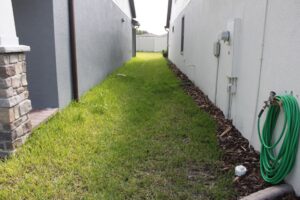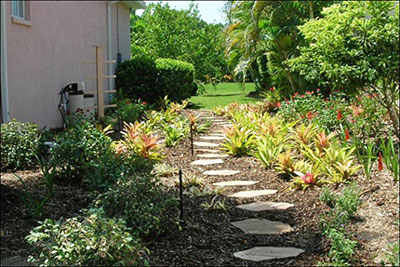
It happens in the best of neighborhoods – the “forgotten zone” that stretches between you and your neighbors. This typically narrow area is usually ignored by homeowners on both sides, but working together, you can save water, improve the health of your landscapes, increase habitat for pollinators, and expand your gardens.
If both neighbors have irrigation systems running, it can easily be overwatered. Even if the distance is just 30 feet across, water seeping into sandy soils does move sideways, usually due to construction grading and can end up creating a muddy mess.
Chances are you and your neighbors don’t both need to water the forgotten zones, and, with good planning, both of you may be able to shut off irrigation entirely.
Chris Claus, water conservation coordinator for the city of St. Petersburg, has a series of tips to help neighbors reclaim their forgotten zones.
- Get to know neighbors on both sides of your house. Open communication is important to your success.
- Identify the benefits for everyone, including water savings, wildlife value and beautification.
- If you’re in a deed-restricted community or have an HOA, check to see if there are any rules about shared spaces, or landscaping areas between homes.
- Are there examples of shared spaces in your community? Make arrangements to tour one and speak with the homeowners.
- Be prepared to perform weeding, mulching and pruning tasks regularly, especially during the first year after planting. Can you and your neighbors realistically make this commitment?
- Measure and create a drawing of the area from wall to wall, front to back. Include any permanent structures, such as air conditioning units, pipes and lights. Add any existing plants that will remain to your plan.
- Discuss the type of garden you will construct. Will there be a pass-through walkway? A patio or bench?
- If planning a pollinator garden, make sure your garden will have something in bloom during all seasons of the year. If planting for birds, have tall, medium and low-growing plants as well as fresh water.
- Consider using micro-irrigation temporarily to water new plants, then turn the system off once plants can survive on their own. You can save up to 60% of your water use with micro-irrigation.
- If you’re concerned about security between the homes, consider installing plants in groups that are widely separated so there are open views. Will low-growing plants alleviate that apprehension? Are security cameras or lights needed?
- Write a neighbor partnership agreement that explains the shared costs including a plant list, mulch and items like paver stones as well as water schedules and labor hours for installation and maintenance. Discuss and document what will be done if a partner moves or can no longer keep maintaining the garden.
- Set an installation date and specify the responsibilities of each neighbor.
- Involve your families and other neighbors, if possible. and other neighbors, if possible. You are setting an example for your children and community.
Take back your forgotten zone to increase habitat for pollinators and save water during this severe drought.
